Tuesday, 26 June, Impressionists abroad and Pur'
Written 1 August 2018
In 1870 and 1871, Paris got uncomfortable and dangerous, because the Franco-Prussian war was raging. France lost that war, ceded Alsace-Lorraine to the victors, and formed a conservative national government. A large segment of Paris was extremely unhappy with that government and formed an alternative, the Paris Commune, which ruled Paris from 18 March to 28 May 1871, but was brutally suppressed. The last of its proponents were hunted down in the Père Lachaise cemetery and shot against a stone wall there (wonderful memorial on the wall along Avenue Gambetta, if you ever get a chance).
To get away from all that, many of the impressionist painters left for Great Britain and worked there for varying periods before drifting back to France after things had calmed down. The Paris city museum of art, housed in the Petit Palais (right across the street from the Grand Palais) mounted an exhibition specifically featuring their work from that period, called "The Impresionists in London." It opened on 21 June and will run through 14 October 2018.
We'd never visited the Petit Palais, in fact had not realized that it was the Paris city museum of art (as distinct from the Musée Carnavalet, which is the museum of the history of Paris through art), so we headed over there on Tuesday morning to have a look.
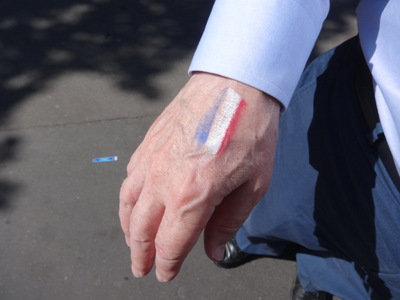
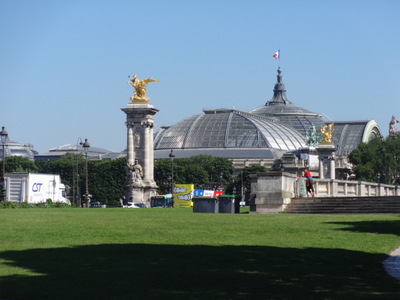 As it happens, the easiest route to the Grand and Petit Palais from our apartment was to take the metro to Invalides, on the left bank near the AIII bridge and to walk back over the bridge to the palaces. In the Invalides metro station, we, along with everyone else, were accosted by jovial fans shouting "Allez les bleus!" ("Go blues!," meaning the French national soccer team, which was competing for the world cup at the time. They later went on to win it, but we were back in the U.s. by then and missed the riots.) They were lined up across the exits, and the idea was that to get past them, you, too, had to shout "Allez les bleus!" and have your hand swiped with little tri-color greasepaint markers they were wielding. We were rooting for the team, so why not? At the left here is David's hand, appropriately marked.
As it happens, the easiest route to the Grand and Petit Palais from our apartment was to take the metro to Invalides, on the left bank near the AIII bridge and to walk back over the bridge to the palaces. In the Invalides metro station, we, along with everyone else, were accosted by jovial fans shouting "Allez les bleus!" ("Go blues!," meaning the French national soccer team, which was competing for the world cup at the time. They later went on to win it, but we were back in the U.s. by then and missed the riots.) They were lined up across the exits, and the idea was that to get past them, you, too, had to shout "Allez les bleus!" and have your hand swiped with little tri-color greasepaint markers they were wielding. We were rooting for the team, so why not? At the left here is David's hand, appropriately marked.
Fortunately, Invalides isn't actually the closest subway stop to the Invalides (that's Latour-Maubourg), so we didn't have to hike the whole length of the esplanade before crossing the river. Here's our view of the near end of the bridge from the metro exit. The building with the glass roof is the Grand Palais, beyond the river.
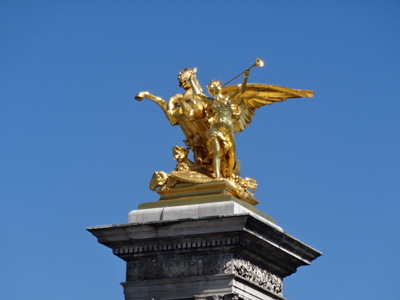
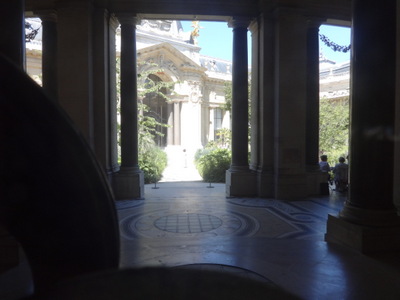 Here's one of the decorative figures that make the bridge so beautiful, reguilded in 1989 for the bicentennial of the revolution.
Here's one of the decorative figures that make the bridge so beautiful, reguilded in 1989 for the bicentennial of the revolution.
And at the right is a partial view of the interior courtyard of the Petit Palais.
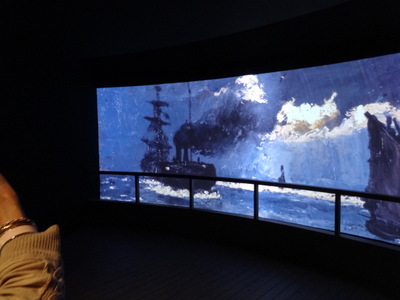
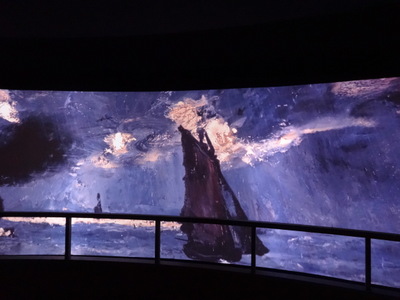
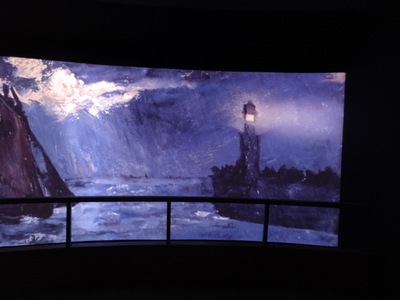 Almost the first thing we saw as we entered the exhibition was a wonderful animation of one of Claude Monet's Crossing the Channel, which I couldn't get into less than three shots (the third one should be to the right of the two here but I couldn't get them to line up that way and still fit on the screen). It was reminiscent of the animations at the Atelier des Lumières—elements of the painting were separated so that they could be moved with respect to one another, and the water heaved and sloshed while still looking just like the stationary water in the painting! The light-house top turned, so that its light periodically swept across the scene and the viewer. I don't know how they do these things, but the effect is terrific.
Almost the first thing we saw as we entered the exhibition was a wonderful animation of one of Claude Monet's Crossing the Channel, which I couldn't get into less than three shots (the third one should be to the right of the two here but I couldn't get them to line up that way and still fit on the screen). It was reminiscent of the animations at the Atelier des Lumières—elements of the painting were separated so that they could be moved with respect to one another, and the water heaved and sloshed while still looking just like the stationary water in the painting! The light-house top turned, so that its light periodically swept across the scene and the viewer. I don't know how they do these things, but the effect is terrific.
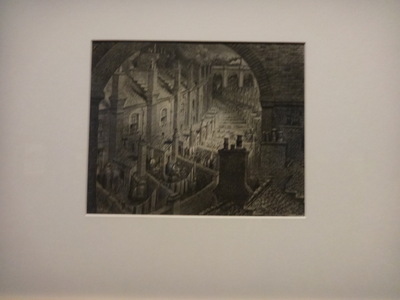
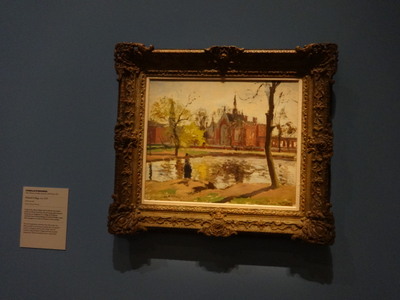 This dark little 1869 engraving by Gustave Doré is called "Above London, from a railroad," and is one of the earliest works in he show.
This dark little 1869 engraving by Gustave Doré is called "Above London, from a railroad," and is one of the earliest works in he show.
The painting at the right is one of the first that Camille Pissarro did after arriving in England. It portrays Dulwich College, where Pissarro's nephew studied. As the label points out, the look of the trees implies it was painted in the fall, soon after Pissarro's arrival in 1870. I loved the way he captured the ripply look of the reflections in the water.
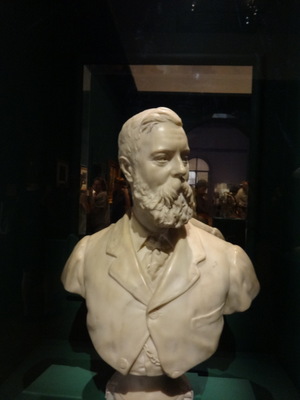
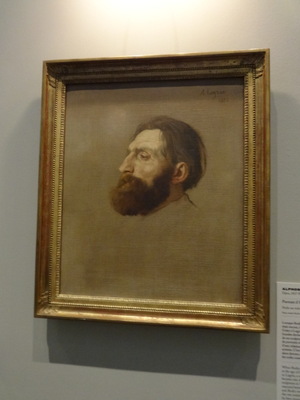 At the left is a marble bust of British painter William Turner, by Jean-Baptiste Carpeaux, the leading French sculptor of his day (looked up to by Rodin). The exhibition also included a great Carpeaux bust of Gounod, who was also sheltering in England from the trouble in France.
At the left is a marble bust of British painter William Turner, by Jean-Baptiste Carpeaux, the leading French sculptor of his day (looked up to by Rodin). The exhibition also included a great Carpeaux bust of Gounod, who was also sheltering in England from the trouble in France.
The portrait at the right is of Auguste Rodin by Alphonse Legros. When Rodin arrived in England he was unknown there, but thanks to his friend Legros, who was already there to receive him, he got established and developed a whole new market for his work.
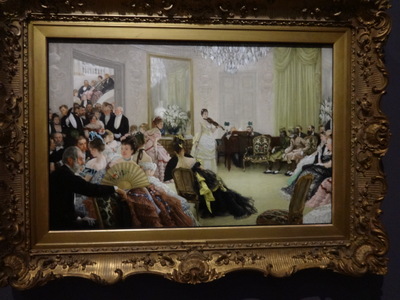
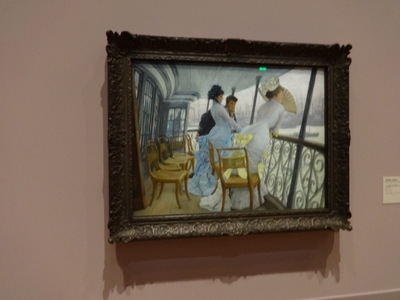 The two paintings here are both by James Tissot. The first shows a young woman preparing to begin a violin recital in a crowded salon and is evocatively titled "Hush!" The second shows fasionable ladies leaning over the rail of H.M.S. Calcutta at Portsmouth.
The two paintings here are both by James Tissot. The first shows a young woman preparing to begin a violin recital in a crowded salon and is evocatively titled "Hush!" The second shows fasionable ladies leaning over the rail of H.M.S. Calcutta at Portsmouth.
Like all the others, this exhibition included reams of information about the artists, the times, the individual works, etc. Among other things it pointed out that, because the French artists all arrived by sea, it tended to be uppermost in their minds, and many of them settled in London, on the Thames, so a large proportion of the works they produced in England featured boats and seascapes.
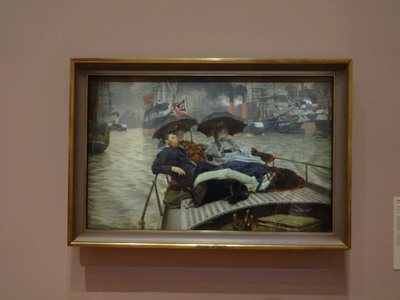
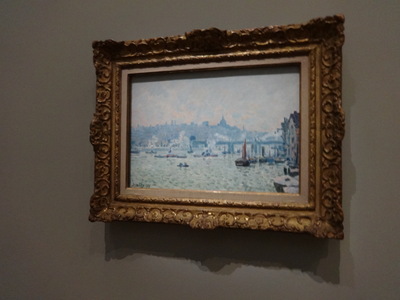 Here are two more on nautical theme. The first is another Tissot, called "On the Thames"; it portrays a young man and two ladies being ferried about on the river. The label points out that, in addition to the boating element, it also echoes a popular literary theme of the time—the difficult choice between two loves.
Here are two more on nautical theme. The first is another Tissot, called "On the Thames"; it portrays a young man and two ladies being ferried about on the river. The label points out that, in addition to the boating element, it also echoes a popular literary theme of the time—the difficult choice between two loves.
The one on the right is by Alfred Sisley and shows a view of the Thames and Charing Cross bridge.
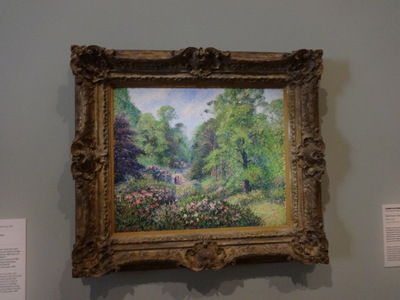
 Pissarro again, at the right, this time in Kew Gardens.
Pissarro again, at the right, this time in Kew Gardens.
At the right is a Whistler, titled "Nocturne in blue and gold: the Old Battersea Bridge."
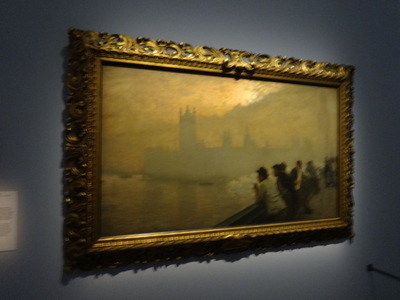
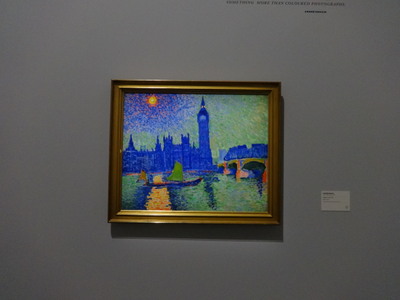 Finally, we come to Monet. Here are the Houses of Parliament in the fog, his very favorite sort of subject.
Finally, we come to Monet. Here are the Houses of Parliament in the fog, his very favorite sort of subject.
And at the right, André Derain's take on Big Ben, in, of course, fauve colors
In addition to the information printed on the walls and the very detailed labels on the individual paintings, each room included a little kiosk with phone receivers where one could listen to conversations (actually letters read aloud by actors) between a brother and sister who lived in London at the time and had diametrically opposed views on the impressionist—she thought they were the coolest thing ever, and he thought they were wackos. I listened to a just few, but I could have spent hours!
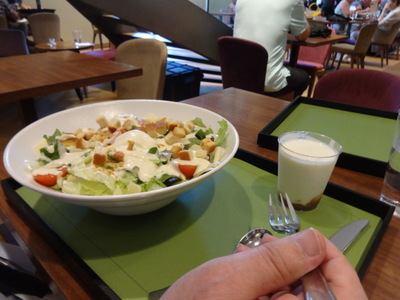
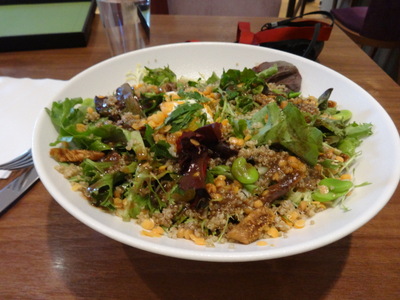 When we'd had all the impressionists our feet could take, we retired to the Petit Palais's cafeteria-style lunch room. David chose the Caesar salad, which came with a whole sliced up chicken breast in it. Also tomatoes, which Americans don't typically put in a Caesar.
When we'd had all the impressionists our feet could take, we retired to the Petit Palais's cafeteria-style lunch room. David chose the Caesar salad, which came with a whole sliced up chicken breast in it. Also tomatoes, which Americans don't typically put in a Caesar.
I decided to try the grain bowl salad, which turned out not to be bad. The grain was mostly quinoa and red lentils (which I guess can both be called grains, if not cereals, on the grounds that they're both seeds), but inaddition to salad greens, it also had some fava beans, walnuts, pine nuts, raisins, diced dried figs in it.
On the edge of David's tray, you can see one of the two fromages blancs with red fruit coulis we had for dessert.
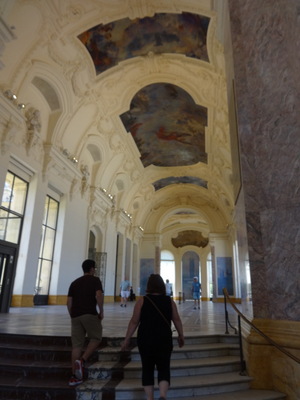
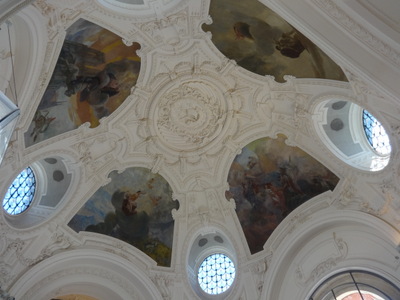 After lunch, we decided to do a quick turn through the permanent collection (which is free!). First, here's a small sample of the architecture of the place. At the left a barrel-vaulted hall with painted ceilings that didn't even display anything; it just led somewhere.
After lunch, we decided to do a quick turn through the permanent collection (which is free!). First, here's a small sample of the architecture of the place. At the left a barrel-vaulted hall with painted ceilings that didn't even display anything; it just led somewhere.
At the right, a dome over one of the galleries, also with painted ceiling panels. At least one of the panels must have been St. George, as it included a guy on horseback with a large sword and a dying dragon.
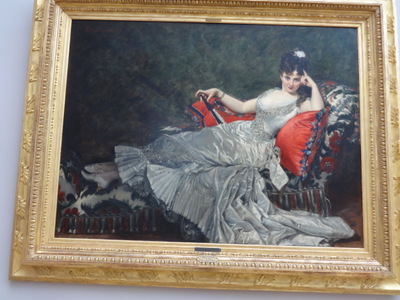
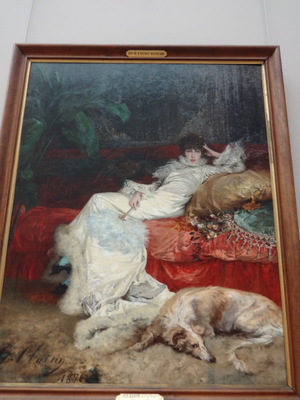 The first gallery displayed these two full-length portraits. The one on the left, by Carolus-Duran, is Mademoiselle de Lancey (née Julia Tahl in Baltimore). She was an heiress in her own right, as well as having a "liaison" with Nissim de Camondo, an art collector and namesake of another wonderful Paris museum. We didn't get there this year, but I plan to drag David there sometime, as he hasn't seen it. Fabulous furniture; fabulous kitchen.
The first gallery displayed these two full-length portraits. The one on the left, by Carolus-Duran, is Mademoiselle de Lancey (née Julia Tahl in Baltimore). She was an heiress in her own right, as well as having a "liaison" with Nissim de Camondo, an art collector and namesake of another wonderful Paris museum. We didn't get there this year, but I plan to drag David there sometime, as he hasn't seen it. Fabulous furniture; fabulous kitchen.
The one at the right is Sarah Bernhardt, painted by Georges Clairin. The first seems to say "come hither" and the second "I'm fine as I am, thanks."
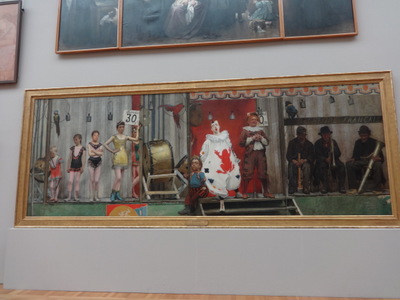
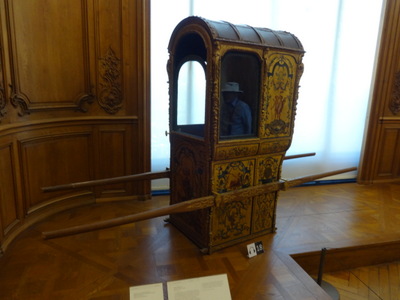 I especially liked this 1998 "Grimaces and Misery—Les Saltimbanques" by Fernand Pelez. As the label points these performers lined up across a platform in front of their tent outline the life story of a circus performer. The four young people at the left (and the fifth one peeking out from the tent) look glum and the little drummer boy at the left end is frankly in tears. The three middled-aged ones in the center panel (the owner, the clown, and the dwarf) look smug and pleased with themselves and and life, and the three old men with musical instruments at the right (labeled "orchestre français" on the board over their heads) look tired and dejected. So apparently, you get roped into the circus at age 5 and cry yourself to sleep until you're old enough to make a living, get some respect, and be a little independent, then as you age, you're relegated to the band, where the guys too old for anything else are stuck. Cheerful.
I especially liked this 1998 "Grimaces and Misery—Les Saltimbanques" by Fernand Pelez. As the label points these performers lined up across a platform in front of their tent outline the life story of a circus performer. The four young people at the left (and the fifth one peeking out from the tent) look glum and the little drummer boy at the left end is frankly in tears. The three middled-aged ones in the center panel (the owner, the clown, and the dwarf) look smug and pleased with themselves and and life, and the three old men with musical instruments at the right (labeled "orchestre français" on the board over their heads) look tired and dejected. So apparently, you get roped into the circus at age 5 and cry yourself to sleep until you're old enough to make a living, get some respect, and be a little independent, then as you age, you're relegated to the band, where the guys too old for anything else are stuck. Cheerful.
At the right here is a very ornate sedan chair once owned by Duke Leopold I of Lorraine (1679–1729) and his wife Elisabeth-Charlotte d'Orléans (1676–1744), niece of Louis XIV. If you look closely at the photo, you can see David sitting it it! (Actually, he's not. He happened fortuitously to walk behind me as I took the photo and is perfectly reflected in the glass window just as though he were inside!)
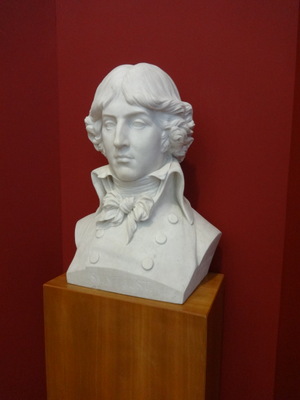
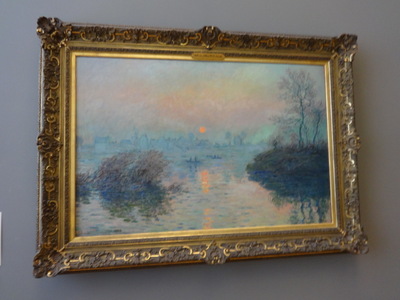 This handsome bust of Antoine de Saint-Just is by David d'Angers, whose work we've often admired elsewhere.
This handsome bust of Antoine de Saint-Just is by David d'Angers, whose work we've often admired elsewhere.
And the painting at the right is of the sun setting on the Seine is by Claude Monet. It's not in the temporary exhibition because it was painted in France. I don't know how they kept it out of the clutches of the Marmottan and especially of the Musée d'Orsay, which is also a Paris city museum. If the Orsay was able to extract all those impressionists from the Louvre, which is national, how did they miss getting this one?!
Again, neither our visit to the museum nor my description of the parts we did see did the place justice. Another place we'll have to visit again in the future.
In passing to and fro to the Grand and Petit Palais, we came across—in the space between the Palais and the bridge—quite a few memorial statues. De Gaulle is there, and Chuchill, and Simon de Bolivar, and it seems to me there was a fourth, but I don't think I got a photo and I don't remember who it was.

 Dinner Tuesday night was at Pur', in the Park Hyatt Paris-Vendôme hotel. When I made the reservation over the phone (another place whose on-line reservation form wouldn't recognize my phone number), I was a little put off when the perky phone lady asked whether we were celebrating anything special. That question always grates a little, as it seems to imply that we're the sort of people who only go to high-end restaurants on special occasions and further that the restaurant's clientel includes a high percentage of such people. I hoped we weren't going to have troops of waiters singing through the dining room, carrying cakes with sparklers stuck in them.
Dinner Tuesday night was at Pur', in the Park Hyatt Paris-Vendôme hotel. When I made the reservation over the phone (another place whose on-line reservation form wouldn't recognize my phone number), I was a little put off when the perky phone lady asked whether we were celebrating anything special. That question always grates a little, as it seems to imply that we're the sort of people who only go to high-end restaurants on special occasions and further that the restaurant's clientel includes a high percentage of such people. I hoped we weren't going to have troops of waiters singing through the dining room, carrying cakes with sparklers stuck in them.
As it happens, I need not have worried. The place was very comfortable, and the service skillful and attentive but not intrusive.
After an amuse-bouche of gougères de Gruyère, tiny tartlets of onions with bacon and quail eggs, little lozenges of piment d'Espellete marshmallow with raspberry, and a "declension of tomatoes and eggplant with fermented tomato water" (pictured at the left), we ordered the "Travel Notebook" tasting menu. I started right off spilling a piece of very ripe raspberry on the tablecloth and making a mess trying to pick it up again. The waiter made no comment, but on his next trip to the table brought along a small, neatly hemmed piece of the tablecloth fabric, which he spread over the spot, hiding it from view for the rest of the meal. It was far too small to be a napking; they must keep such items just to cover unsightly stains!
First course (at the right): Barely cooked langoustines (Nephrops norvegicus, Dublin bay prawns) "from the isles of the East," with "fennel snow," lemon caviar and coral (i.e. langoustine roe) cream. Why "from the isles of the East? Are they out of season in Brittany? Very good, though.
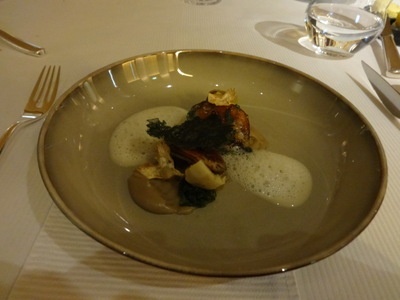
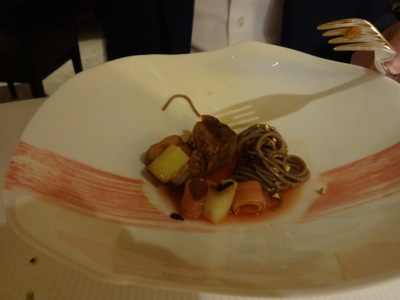 Second course: Wild-caught abalone from Brittany, sautéed in algae butter with a poivrade of artichoke(in three forms this time: chunks, purée, and crispy fried thin slices), vandouvan, and puffed rice.
Third course: Duck foie gras "like a shabu-shabu". in rhubarb consommé with soba noodles. Now we had carefully explained that David cannot eat buckwheat, but they served him the noodles anyway, so I ate them. The shabu-shabu included slices of carrot, leek, and other vegetables.
Second course: Wild-caught abalone from Brittany, sautéed in algae butter with a poivrade of artichoke(in three forms this time: chunks, purée, and crispy fried thin slices), vandouvan, and puffed rice.
Third course: Duck foie gras "like a shabu-shabu". in rhubarb consommé with soba noodles. Now we had carefully explained that David cannot eat buckwheat, but they served him the noodles anyway, so I ate them. The shabu-shabu included slices of carrot, leek, and other vegetables.
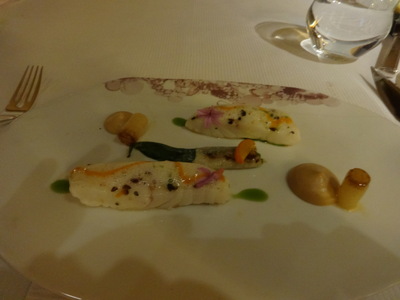
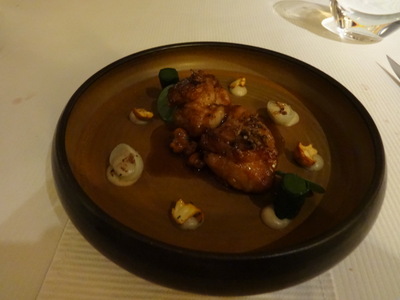 Fourth course: Turbot "from our coasts" stewed with aromatic vegetables, "grains de paradis" (Aframomum melegueta, a close relative of cardamom), bear garlic, kumquat, and kohlrabi. The brown-tipped cylinders are the kohlrabi, and I think that's the bear garlic in the middle between the two pieces of fish.
Fourth course: Turbot "from our coasts" stewed with aromatic vegetables, "grains de paradis" (Aframomum melegueta, a close relative of cardamom), bear garlic, kumquat, and kohlrabi. The brown-tipped cylinders are the kohlrabi, and I think that's the bear garlic in the middle between the two pieces of fish.
Fifth course: Veal sweetbreads (David really has come a long way). They were sautéed with "licoriced powder," and came with smoked spinach, mousserons (Calocybe gambosa, St. George's mushroom), and a jus of Banyuls vinegar. Yummy.
Our cheeses, from a trolley stocked by a named supplier, were (for David) bleu de Gex, a 36-month cantal, and a creamy chevre that was a rectangular brick and (for me) Valençay, Époisse, and palette de something (a creamy, crumbly chevre). David pronounced the blue de Gex "weird" and didn't care for it (Gex is a place, where the cheese comes from). Otherwise, they were all great. I love Valenç, and this was the first of the trip.
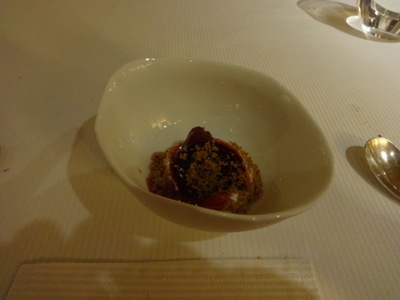
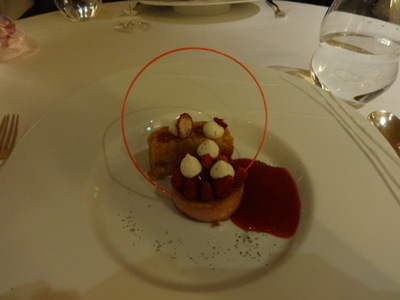 Predessert: a preparation of stewed cherries on a creamy base.
Predessert: a preparation of stewed cherries on a creamy base.
First official dessert: a "garden of wild strawberries" with a caramelized Napoleon, verbena whipped cream, and beebalm-flower sorbet. The "handle" on the basket is spun sugar.
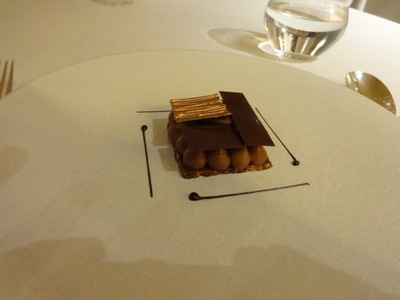
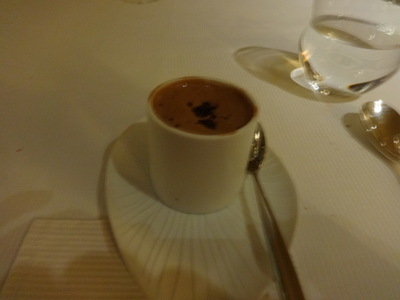 Second dessert: La Tablette. In French, any large chocolate bar scored into squares (the way Hershey bars are) is called a "tablette." If you fly in an Air France plane (as you often do if you take Delta to Europe), you'll see in the
security video a visual pun in which the stewardess announces that it's time to "stow your computers and tablets," and one of the passenger carefully puts away a huge chocolate bar. Anyway, this chocolate dessert consisted of a chocolate nut cookie base with a layer of puffs of chocolate ganache arranged in a grid pattern and topped with thin sheets of chocolate, one of them gilded (but with harmless culinary guilding spray, not that dratted gold foil).
Second dessert: La Tablette. In French, any large chocolate bar scored into squares (the way Hershey bars are) is called a "tablette." If you fly in an Air France plane (as you often do if you take Delta to Europe), you'll see in the
security video a visual pun in which the stewardess announces that it's time to "stow your computers and tablets," and one of the passenger carefully puts away a huge chocolate bar. Anyway, this chocolate dessert consisted of a chocolate nut cookie base with a layer of puffs of chocolate ganache arranged in a grid pattern and topped with thin sheets of chocolate, one of them gilded (but with harmless culinary guilding spray, not that dratted gold foil).
It was accompanied by a "chaudfroid," a sort of cup of hot chocolate sauce.
David had the wine pairings with his dinner, so he had several discussions with the young sommelier in the course of the meal, as did I, when we had questions about the menu, all in French. But then we heard him talk to the table behind me in perfect, ideomatic American English! The next time he went by I said, "I have to ask, are you American?" He was, from Berkeley, California! We then had a long talk, in English, about how he managed to land the sommelier job in such a high-end French restaurant. It helped that Hyatt is an American chain. He's apparently been there about two years and is thinking it's time to move on. He French was great, and he claimed he hadn't realized we were American (but he may just have been being polite). Having gained experience and perfected his French, he'd like to go back to the states to work there again.
The custom of sending diners off at the end of the meal with a gift from the kitchen seems to have gotten less common, but at Pur' they presented us at the door with a large sugared brioche "for tomorrow's breakfast."
Previous entry
List of Entries
Next entry

 As it happens, the easiest route to the Grand and Petit Palais from our apartment was to take the metro to Invalides, on the left bank near the AIII bridge and to walk back over the bridge to the palaces. In the Invalides metro station, we, along with everyone else, were accosted by jovial fans shouting "Allez les bleus!" ("Go blues!," meaning the French national soccer team, which was competing for the world cup at the time. They later went on to win it, but we were back in the U.s. by then and missed the riots.) They were lined up across the exits, and the idea was that to get past them, you, too, had to shout "Allez les bleus!" and have your hand swiped with little tri-color greasepaint markers they were wielding. We were rooting for the team, so why not? At the left here is David's hand, appropriately marked.
As it happens, the easiest route to the Grand and Petit Palais from our apartment was to take the metro to Invalides, on the left bank near the AIII bridge and to walk back over the bridge to the palaces. In the Invalides metro station, we, along with everyone else, were accosted by jovial fans shouting "Allez les bleus!" ("Go blues!," meaning the French national soccer team, which was competing for the world cup at the time. They later went on to win it, but we were back in the U.s. by then and missed the riots.) They were lined up across the exits, and the idea was that to get past them, you, too, had to shout "Allez les bleus!" and have your hand swiped with little tri-color greasepaint markers they were wielding. We were rooting for the team, so why not? At the left here is David's hand, appropriately marked.
 Here's one of the decorative figures that make the bridge so beautiful, reguilded in 1989 for the bicentennial of the revolution.
Here's one of the decorative figures that make the bridge so beautiful, reguilded in 1989 for the bicentennial of the revolution.

 Almost the first thing we saw as we entered the exhibition was a wonderful animation of one of Claude Monet's Crossing the Channel, which I couldn't get into less than three shots (the third one should be to the right of the two here but I couldn't get them to line up that way and still fit on the screen). It was reminiscent of the animations at the Atelier des Lumières—elements of the painting were separated so that they could be moved with respect to one another, and the water heaved and sloshed while still looking just like the stationary water in the painting! The light-house top turned, so that its light periodically swept across the scene and the viewer. I don't know how they do these things, but the effect is terrific.
Almost the first thing we saw as we entered the exhibition was a wonderful animation of one of Claude Monet's Crossing the Channel, which I couldn't get into less than three shots (the third one should be to the right of the two here but I couldn't get them to line up that way and still fit on the screen). It was reminiscent of the animations at the Atelier des Lumières—elements of the painting were separated so that they could be moved with respect to one another, and the water heaved and sloshed while still looking just like the stationary water in the painting! The light-house top turned, so that its light periodically swept across the scene and the viewer. I don't know how they do these things, but the effect is terrific.
 This dark little 1869 engraving by Gustave Doré is called "Above London, from a railroad," and is one of the earliest works in he show.
This dark little 1869 engraving by Gustave Doré is called "Above London, from a railroad," and is one of the earliest works in he show.

 At the left is a marble bust of British painter William Turner, by Jean-Baptiste Carpeaux, the leading French sculptor of his day (looked up to by Rodin). The exhibition also included a great Carpeaux bust of Gounod, who was also sheltering in England from the trouble in France.
At the left is a marble bust of British painter William Turner, by Jean-Baptiste Carpeaux, the leading French sculptor of his day (looked up to by Rodin). The exhibition also included a great Carpeaux bust of Gounod, who was also sheltering in England from the trouble in France.
 The two paintings here are both by James Tissot. The first shows a young woman preparing to begin a violin recital in a crowded salon and is evocatively titled "Hush!" The second shows fasionable ladies leaning over the rail of H.M.S. Calcutta at Portsmouth.
The two paintings here are both by James Tissot. The first shows a young woman preparing to begin a violin recital in a crowded salon and is evocatively titled "Hush!" The second shows fasionable ladies leaning over the rail of H.M.S. Calcutta at Portsmouth.
 Here are two more on nautical theme. The first is another Tissot, called "On the Thames"; it portrays a young man and two ladies being ferried about on the river. The label points out that, in addition to the boating element, it also echoes a popular literary theme of the time—the difficult choice between two loves.
Here are two more on nautical theme. The first is another Tissot, called "On the Thames"; it portrays a young man and two ladies being ferried about on the river. The label points out that, in addition to the boating element, it also echoes a popular literary theme of the time—the difficult choice between two loves.
 Pissarro again, at the right, this time in Kew Gardens.
Pissarro again, at the right, this time in Kew Gardens.
 Finally, we come to Monet. Here are the Houses of Parliament in the fog, his very favorite sort of subject.
Finally, we come to Monet. Here are the Houses of Parliament in the fog, his very favorite sort of subject.
 When we'd had all the impressionists our feet could take, we retired to the Petit Palais's cafeteria-style lunch room. David chose the Caesar salad, which came with a whole sliced up chicken breast in it. Also tomatoes, which Americans don't typically put in a Caesar.
When we'd had all the impressionists our feet could take, we retired to the Petit Palais's cafeteria-style lunch room. David chose the Caesar salad, which came with a whole sliced up chicken breast in it. Also tomatoes, which Americans don't typically put in a Caesar.
 After lunch, we decided to do a quick turn through the permanent collection (which is free!). First, here's a small sample of the architecture of the place. At the left a barrel-vaulted hall with painted ceilings that didn't even display anything; it just led somewhere.
After lunch, we decided to do a quick turn through the permanent collection (which is free!). First, here's a small sample of the architecture of the place. At the left a barrel-vaulted hall with painted ceilings that didn't even display anything; it just led somewhere.
 The first gallery displayed these two full-length portraits. The one on the left, by Carolus-Duran, is Mademoiselle de Lancey (née Julia Tahl in Baltimore). She was an heiress in her own right, as well as having a "liaison" with Nissim de Camondo, an art collector and namesake of another wonderful Paris museum. We didn't get there this year, but I plan to drag David there sometime, as he hasn't seen it. Fabulous furniture; fabulous kitchen.
The first gallery displayed these two full-length portraits. The one on the left, by Carolus-Duran, is Mademoiselle de Lancey (née Julia Tahl in Baltimore). She was an heiress in her own right, as well as having a "liaison" with Nissim de Camondo, an art collector and namesake of another wonderful Paris museum. We didn't get there this year, but I plan to drag David there sometime, as he hasn't seen it. Fabulous furniture; fabulous kitchen.
 I especially liked this 1998 "Grimaces and Misery—Les Saltimbanques" by Fernand Pelez. As the label points these performers lined up across a platform in front of their tent outline the life story of a circus performer. The four young people at the left (and the fifth one peeking out from the tent) look glum and the little drummer boy at the left end is frankly in tears. The three middled-aged ones in the center panel (the owner, the clown, and the dwarf) look smug and pleased with themselves and and life, and the three old men with musical instruments at the right (labeled "orchestre français" on the board over their heads) look tired and dejected. So apparently, you get roped into the circus at age 5 and cry yourself to sleep until you're old enough to make a living, get some respect, and be a little independent, then as you age, you're relegated to the band, where the guys too old for anything else are stuck. Cheerful.
I especially liked this 1998 "Grimaces and Misery—Les Saltimbanques" by Fernand Pelez. As the label points these performers lined up across a platform in front of their tent outline the life story of a circus performer. The four young people at the left (and the fifth one peeking out from the tent) look glum and the little drummer boy at the left end is frankly in tears. The three middled-aged ones in the center panel (the owner, the clown, and the dwarf) look smug and pleased with themselves and and life, and the three old men with musical instruments at the right (labeled "orchestre français" on the board over their heads) look tired and dejected. So apparently, you get roped into the circus at age 5 and cry yourself to sleep until you're old enough to make a living, get some respect, and be a little independent, then as you age, you're relegated to the band, where the guys too old for anything else are stuck. Cheerful.
 This handsome bust of Antoine de Saint-Just is by David d'Angers, whose work we've often admired elsewhere.
This handsome bust of Antoine de Saint-Just is by David d'Angers, whose work we've often admired elsewhere.
 Dinner Tuesday night was at Pur', in the Park Hyatt Paris-Vendôme hotel. When I made the reservation over the phone (another place whose on-line reservation form wouldn't recognize my phone number), I was a little put off when the perky phone lady asked whether we were celebrating anything special. That question always grates a little, as it seems to imply that we're the sort of people who only go to high-end restaurants on special occasions and further that the restaurant's clientel includes a high percentage of such people. I hoped we weren't going to have troops of waiters singing through the dining room, carrying cakes with sparklers stuck in them.
Dinner Tuesday night was at Pur', in the Park Hyatt Paris-Vendôme hotel. When I made the reservation over the phone (another place whose on-line reservation form wouldn't recognize my phone number), I was a little put off when the perky phone lady asked whether we were celebrating anything special. That question always grates a little, as it seems to imply that we're the sort of people who only go to high-end restaurants on special occasions and further that the restaurant's clientel includes a high percentage of such people. I hoped we weren't going to have troops of waiters singing through the dining room, carrying cakes with sparklers stuck in them.
 Second course: Wild-caught abalone from Brittany, sautéed in algae butter with a poivrade of artichoke(in three forms this time: chunks, purée, and crispy fried thin slices), vandouvan, and puffed rice.
Third course: Duck foie gras "like a shabu-shabu". in rhubarb consommé with soba noodles. Now we had carefully explained that David cannot eat buckwheat, but they served him the noodles anyway, so I ate them. The shabu-shabu included slices of carrot, leek, and other vegetables.
Second course: Wild-caught abalone from Brittany, sautéed in algae butter with a poivrade of artichoke(in three forms this time: chunks, purée, and crispy fried thin slices), vandouvan, and puffed rice.
Third course: Duck foie gras "like a shabu-shabu". in rhubarb consommé with soba noodles. Now we had carefully explained that David cannot eat buckwheat, but they served him the noodles anyway, so I ate them. The shabu-shabu included slices of carrot, leek, and other vegetables.

 Fourth course: Turbot "from our coasts" stewed with aromatic vegetables, "grains de paradis" (Aframomum melegueta, a close relative of cardamom), bear garlic, kumquat, and kohlrabi. The brown-tipped cylinders are the kohlrabi, and I think that's the bear garlic in the middle between the two pieces of fish.
Fourth course: Turbot "from our coasts" stewed with aromatic vegetables, "grains de paradis" (Aframomum melegueta, a close relative of cardamom), bear garlic, kumquat, and kohlrabi. The brown-tipped cylinders are the kohlrabi, and I think that's the bear garlic in the middle between the two pieces of fish.
 Predessert: a preparation of stewed cherries on a creamy base.
Predessert: a preparation of stewed cherries on a creamy base.
 Second dessert: La Tablette. In French, any large chocolate bar scored into squares (the way Hershey bars are) is called a "tablette." If you fly in an Air France plane (as you often do if you take Delta to Europe), you'll see in the
security video a visual pun in which the stewardess announces that it's time to "stow your computers and tablets," and one of the passenger carefully puts away a huge chocolate bar. Anyway, this chocolate dessert consisted of a chocolate nut cookie base with a layer of puffs of chocolate ganache arranged in a grid pattern and topped with thin sheets of chocolate, one of them gilded (but with harmless culinary guilding spray, not that dratted gold foil).
Second dessert: La Tablette. In French, any large chocolate bar scored into squares (the way Hershey bars are) is called a "tablette." If you fly in an Air France plane (as you often do if you take Delta to Europe), you'll see in the
security video a visual pun in which the stewardess announces that it's time to "stow your computers and tablets," and one of the passenger carefully puts away a huge chocolate bar. Anyway, this chocolate dessert consisted of a chocolate nut cookie base with a layer of puffs of chocolate ganache arranged in a grid pattern and topped with thin sheets of chocolate, one of them gilded (but with harmless culinary guilding spray, not that dratted gold foil).